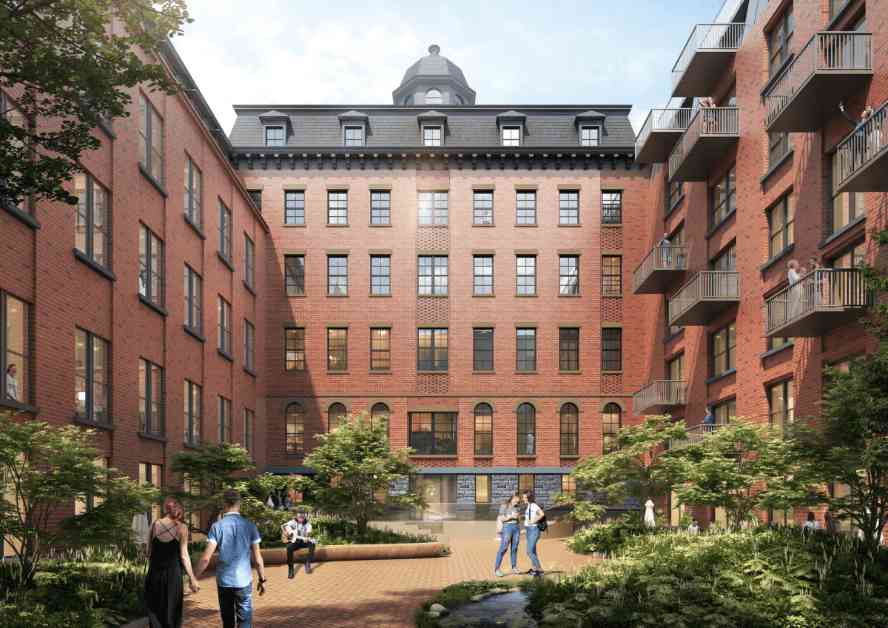The Hartby Apartments: A Historic Transformation in Bed-Stuy
A significant transformation is underway in the heart of Bedford-Stuyvesant, as the iconic St. John’s College campus is being repurposed into a modern apartment complex. This adaptive reuse project will not only preserve an important part of Bed-Stuy’s history but also provide much-needed housing in the area, with over 200 mostly market-rate apartments set to be created.
St. John’s College, located on Lewis Avenue between Willoughby Avenue and Hart Street, is a quarter-block campus that has long been a landmark in the neighborhood. The project, which is currently in progress, aims to convert the historic buildings into residential units while maintaining their architectural integrity.
Historic Preservation and Modernization
While the majority of the historic buildings on the campus will remain unaltered on the exterior, the oldest wing along Willoughby Avenue has been demolished and is being replaced by a similar new building that has already topped out. This blending of old and new ensures that the essence of the original structures is preserved while meeting the needs of modern residents.
The Romanesque Revival architecture of St. John’s College, originally built in the 19th century, is a testament to the rich history of the area. Designed by architect Patrick Keely and built by the Catholic Church, the buildings feature distinctive elements such as multicolored slate mansard roofs, arched windows, and a round corner tower. The campus, which housed the college until the 1950s, has since been used by various educational and service organizations.
Adaptive Reuse and Community Impact
The decision to convert the St. John’s College campus into apartments represents a unique opportunity to repurpose a historic site for contemporary use. Despite the complex not being landmarked, developers chose to adapt the buildings rather than demolish them, potentially due to their eligibility for tax credits for adaptive reuse.
The project, facilitated through a partnership between a private developer and the Roman Catholic Church, will result in the creation of 205 studio, one-, and two-bedroom apartments. The new wing along Willoughby Avenue will be six stories high and will closely resemble the original buildings in design, with modern updates to enhance functionality and aesthetics.
Community Engagement and Cultural Preservation
The transformation of St. John’s College into The Hartby Apartments signifies more than just a change in land use—it represents a commitment to preserving the cultural heritage of Bed-Stuy. The new complex will offer a mix of market-rate and income-restricted apartments, providing housing options for a diverse range of residents.
A recent housing lottery for the revamped complex attracted applicants from various income brackets, with rents for lottery units ranging from $2,495 for a studio to $3,939 for a two-bedroom apartment. The 421-a tax program, which the development benefits from, allows for a mix of market-rate and affordable units to cater to different income levels in the community.
Future Prospects and Neighborhood Revitalization
As the construction of The Hartby Apartments nears completion, anticipation is building for the impact it will have on the surrounding neighborhood. The new complex will not only provide much-needed housing but also offer a range of amenities, including a roof terrace, parking, a gym, and a dog washing station, to enhance the quality of life for residents.
The revitalization of the St. John’s College campus is a testament to the resilience and adaptability of historic structures in urban environments. By repurposing these buildings for modern use, developers are not only preserving the architectural legacy of Bed-Stuy but also contributing to the revitalization of the community as a whole.
Preserving History Through Adaptive Reuse
The adaptive reuse of historic buildings is a sustainable approach to urban development that helps preserve the character and identity of neighborhoods. By repurposing existing structures rather than demolishing them, developers can retain the unique architectural features that make a place special while meeting the needs of contemporary residents.
In the case of St. John’s College, the decision to convert the campus into apartments represents a thoughtful balance between preserving history and meeting the demands of a growing city. The integration of modern amenities and design elements into the existing buildings ensures that the new complex will be both functional and visually appealing.
Community Engagement and Affordable Housing
The inclusion of income-restricted apartments in The Hartby Apartments reflects a commitment to providing affordable housing options in a rapidly gentrifying neighborhood. By offering a mix of market-rate and affordable units, developers are helping to maintain the socioeconomic diversity of Bed-Stuy and ensure that residents of all income levels can continue to call the area home.
The recent housing lottery for the complex underscores the high demand for affordable housing in the area, with hundreds of applicants vying for a chance to secure a unit in the new development. The pricing structure of the apartments, which is tied to the Area Median Income, ensures that rents remain affordable for a wide range of residents.
Future Impact and Sustainability
As The Hartby Apartments prepare to open their doors to residents, the future impact of the project on the neighborhood remains to be seen. The revitalization of the St. John’s College campus is expected to breathe new life into the area, attracting new residents and businesses to the historic district.
The sustainable design features of the new complex, including energy-efficient systems and green building materials, will help reduce the environmental impact of the development and promote a more sustainable way of living. By incorporating modern amenities and green spaces into the project, developers are creating a vibrant and livable community for current and future residents.
In conclusion, the transformation of the St. John’s College campus into The Hartby Apartments represents a unique opportunity to preserve a piece of Bed-Stuy’s history while meeting the housing needs of a growing city. By repurposing the historic buildings for modern use, developers are creating a sustainable and vibrant community that honors the past while looking towards the future.




